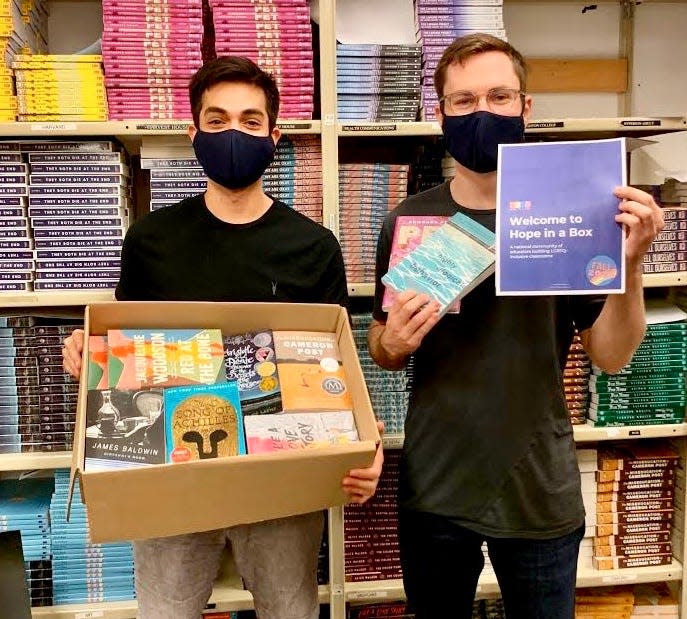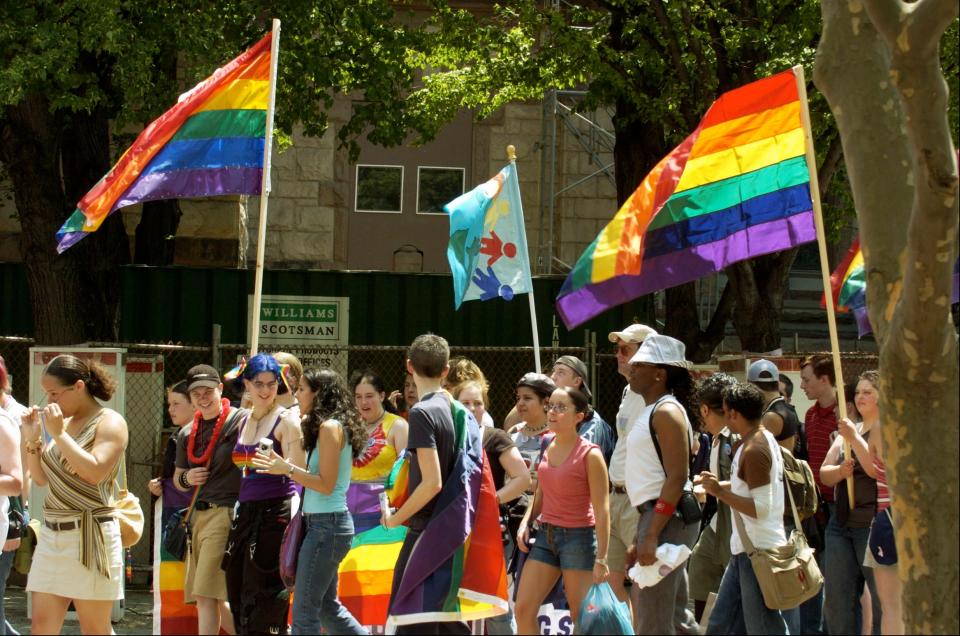LGBTQ-inclusive books are hard to find. So these groups started sending them to schools.
When Lisa Forman's daughter Becca Damante came out as queer in middle school, the loving mother couldn't shake one recurring thought: What was it like for her child when she started reading mainstream books – ones that lacked LGBTQ-inclusive storylines?
In November, Forman decided to take action to help other LGBTQ kids.
“I’m thinking about all those books that could have been there for my kid and other kids," said Forman, 55.
For Forman, lack of LGBTQ affirmation in schools led her to found Pride and Less Prejudice, a national organization that has been donating age-appropriate LGBTQ-inclusive books to preschool through third grade classes since last year. The group has been donating even more books this year during the pandemic.
Though many classes are virtual, some LGBTQ students attending school this fall are returning to their biggest support systems and havens: teachers and their curriculums.
Research shows having LGBTQ storylines in the classroom affects all students, not just those who think they may be LGBTQ. Students in schools with LGBTQ-inclusive curriculum are 82% more likely to report that their classmates are accepting of LGBTQ people than students in schools without LGBTQ-inclusive curriculums, according to the GLSEN National School Climate Survey.
A recent survey from The Trevor Project, a national group focused on suicide prevention among LGBTQ young people, also shows that positive school environments make the biggest difference in kids' lives, compared with other environments such as the home, the community and work settings.
When Forman used to work as a preschool teacher, she said she was struck by how quickly kids ingested new knowledge and developed new ways of thinking. That's why it's important to introduce children to characters who have two moms or two dads and characters who express gender outside the male-female binary, she said.
Something else clicked for Forman when she and Damante watched the comedy-drama series "Glee" together when it premiered in 2009: it was obvious that Damante identified with LGBTQ storylines more than others.
“If we start with this next generation of young kids and we make it so that it’s normal, it’s just a fact, it’s not anything unusual. Then a whole new generation of people will be just fine with it, and people will feel comfortable," she said.
Pride and Less Prejudice sends book bundles to any educator in the U.S. or Canada who requests them for use in their class. In addition to international requests from multiple Canadian provinces, Forman said she has also received requests for books and resources from Australia, Denmark and Angola. So far, the group has sent books to schools in 22 states and received requests from teachers in 37 states.
Hope In A Box, a similar group founded in 2018, gives free literature and curriculums with LGBTQ characters, themes or authors to middle and high school English classes.
Its founder, Joe English, said he created the group because LGBTQ acceptance is a matter of life and death. English, 25, describes the threat of violence LGBTQ young people face as "real and pressing," especially in rural schools, which make up 90% of the group's partner schools.
English said 90% of teachers he works with tell him their LGBTQ students are physically harassed because of their identity. Two-thirds say their LGBTQ students have been punched or kicked in the past year, he said.
With many classes held virtually, English said "it is even more important than normal that they feel safe and welcome and included," in educational settings where they can claim representation in books and lessons.

LGBTQ youths need representation in kid-centered spaces
For Damante, 25, finding LGBTQ-inclusive spaces was hard when she was a kid in New Jersey.
"I didn’t have access to things like Pride where I was growing up," she said.
Damante recalls how she and a straight high-school classmate went to an LGBTQ bowling meet-up to try to make more queer friends their age. They soon left, disappointed when they realized the event was attended entirely by adults.
Until college, Damante said she mostly found herself represented in television and movies. Those included slightly more gay, lesbian and bisexual characters in recent years, although she notes transgender characters are still lacking.
Bringing books with LGBTQ protagonists and families to children is about helping people see themselves and their loved ones in ways that are both new and more true-to-life, Damante said.
"When you really think about how you were socialized, there’s a lot of things that are missing that you don’t realize until you’re much older," she said. "A lot of people don’t realize that these books are out there."

India Macdonald, 19, was one of the first students to receive books from Hope In A Box when she was a high school student in Topeka, Kansas. Before then, "reading and watching TV and movies secretly in my bedroom was so important," she said.
Macdonald, who is a lesbian, said one of her favorite Hope In A Box books is "The Miseducation of Cameron Post" by Emily M. Danforth. The novel tells the story of a 12-year-old girl living in Montana who goes to live with her aunt and grandmother after her parents die in a car crash. The protagonist explores relationships with other girls, which creates tension among the town's religious community.
She felt a sense of relief when her English teacher incorporated books such as Danforth's as part of a unit on gender studies, Macdonald said.
"When your teacher brings this into the classroom, that communicates to you that this is not something you need to hide or feel weird about," India said.
Schools can't always afford inclusive curriculums
When Jack Meyers, 27, taught third grade in Franklin Township, New Jersey, it was cost-prohibitive to get "anything other than absolutely the basics," he said.
Meyers said the students at the public elementary school where he taught are mostly Black and Latino. The school is also Title I – an institution receiving financial aid so low-income students can meet academic standards – just like 45% of schools supported by Pride and Less Prejudice.
Meyers says he and his colleagues felt pressure to resort to curriculums his school already had on hand because of a lack of funding.
"Those end up being Eurocentric, white-washed version of life," he said.
Meyers, who started receiving books from Pride and Less Prejudice in November 2019, said books such as "Cuando Amamos Cantamos: When We Love Someone We Sing to Them" by Ernesto Javier Martínez helped him be a better teacher to the English language learners he taught.
"As teachers, we need to understand that if we don’t think critically about the kinds of texts we’re using in the classroom, we are subconsciously promoting the status quo," he said.
Inclusive media may be most important for non-LGBTQ students
For Drake Brown, who is straight, volunteering as Digital Chair for Hope In A Box meant taking his allyship to the next level.
"I’ve been fortunate enough to grow up with a gay uncle who happens to be one of my biggest role models," Brown, 23, said.
Brown, who attended school in rural New Jersey, said he never engaged with LGBTQ people or material in class.
He said he always felt a disconnect between the stories his uncle told him about LGBTQ people fighting for civil rights and what he his teachers taught him.
"While you may not have many LGBTQ people in your classroom, that’s not an accurate depiction of what society really is when you step outside your community and your bubble," he said.
Brown is also Black and said this year's national spotlight on racial injustice points to a similar disconnect: "A lot of folks don’t really empathize with our struggles because they don’t visually see them in their day-to-day. But it’s as simple as turning your television on."
Follow Claire Thornton on Twitter @claire_thornto.
This article originally appeared on USA TODAY: LGBTQ books: Groups donate schools age-appropriate, inclusive stories

